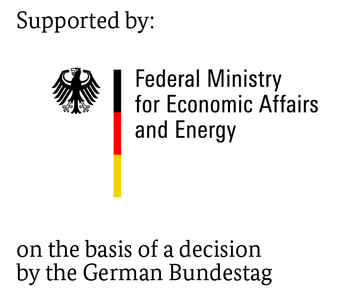You are here: / Home
Industry 4.0 membrane heat and mass exchanger (i-MWÜ4.0)

EuroNorm INNO-KOM
04/2019 - 09/2021
Dipl.-Ing. (FH) Hannes Rosenbaum
+49-351-4081-5324
completed
Linking the entire life cycle of a multi-functional air handling unit
Membrane heat and mass exchanger ...
... enable heat and mass transfer without direct contact of the media involved. A large number of the resulting application potentials and fields of application have already been successfully tested on a laboratory scale at the ILK Dresden. These include
- Air humidification
- condensate-free sorptive air dehumidification
- Heat and moisture recovery in a closed system
- Indirect evaporative cooling in air conditioning and process air technology.
Objective
To meet Industry 4.0 and quality assurance standards, design, assembly and test procedures were developed that can be networked with planning, design and production. In addition, procedures were developed for energy and hygienic condition diagnosis during operation, and a parameter-guided maintenance management system for quality assurance was derived from this.
![[Translate to EN:] Interaktion eines i-MWÜ4.0](/fileadmin/_processed_/6/d/csm_Projektbild2mitText_50af199a64.jpg)
The call for the use of energy-efficient and sustainable technologies and processes in air conditioning is particularly relevant to humidification and dehumidification. Example: liquid sorption processes. Innovative membrane heat and mass transfer units can help here. They are designed on the basis of measured values and then tested, maintained and optimised over their entire life cycle.
Dipl.-Ing. (FH) Hannes Rosenbaum
Approach
The development of the Industry 4.0 Membrane Heat and Mass Exchangers was based on four main areas (tools):
- For the TESTING TOOL, approaches were developed to adapt common test methods for leakage, tightness, permeability and processing quality with regard to non-destructive testing on semi-finished products (iMWÜ production) and in plant operation.
- The DIAGNOSETOOL and the CONTROLLING AND NETWORKING TOOL of the iMWÜ4.0 were developed on the basis of the acquisition, storage and evaluation of long-term measurement data from a functional sample. The focus was on hygienic (risk of mould) and energy aspects. Numerical calculations using balance equations for mass, momentum, energy and species support self-diagnosis and machine learning, as do material properties from laboratory tests. Computational algorithms have been specifically programmed for implementation in an online monitoring system - for comparison and analysis of real and comparative processes.
- The solution approach for the MANUFACTURING TOOL (automatable production of the i-MWÜ4.0) was the conceptual constructive revision with regard to automatable production/manufacturing and assembly. Preference was given to materials, components, semi-finished products, joints and joining techniques that are suitable for series production and that enable the arrangement of components and the assembly process to be coordinated.
Outcomes
The results of the successfully completed R&D project include:
- A test method including a test device for non-destructive testing of flowable, multi-layer textile composites (patent pending): Tightness/leakage and processing quality testing on unassembled semi-finished products
- Monitoring of iMWÜ4.0 status data (LabView)
- implemented algorithm for hygienic self-diagnosis regarding the risk of mould growth
- Implementable Python code of the ideal comparison process in iMWÜ4.0 as well as the calculation of real material properties from measurement data for online analysis in the form of a target/actual comparison
- New design approaches for 2- and 3-fluid membrane heat and mass exchangers
Interested?
Beyond the research project, we are planning to form a competent consortium that will cover the entire process chain, from the design, manufacture and processing of textile heat and mass transfer surfaces to plant construction, process control and energy management at the end product at the end user. Co-operation with institutes and companies from different industries is possible and desired at any time:
- Textile manufacturing
- Textile finishing
- Materials testing
- Membrane technology
- Institutes involved in textile research and plastics technology
- Plastics processing and packaging
- Air and refrigeration technology and
- AHU manufacturers and suppliers
- End users
Please get in touch if you are interested to work with us.
Further Projects
All-in-one device for freeze-drying and production of biomaterial
with automated freezing and sterilisation option
Certification of efficient air conditioning and ventilation systems through the new "indoor air quality seal" for non-residential buildings
Good news for building owners, architects, general contractors and specifiers:
Investigation according to DIN EN ISO 14903
These tests according to DIN EN ISO 14903 are possible at ILK Dresden






















